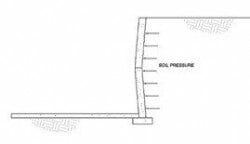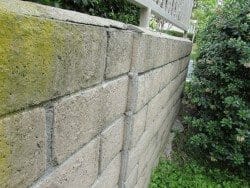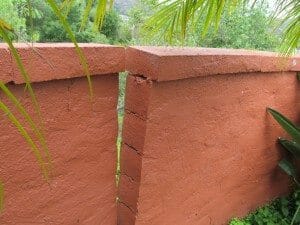Cracked Retaining Walls
Home » Yard, drive, walks, patios » Retaining walls »
Published: January 31, 2014 Last Updated: July 1, 2021
It is very common to see some cracking or leaning in a retaining wall. Generally, it is not a major concern and is often left as is. With that being said, there are some circumstances where consulting with an engineer is wise.

Common Causes for Retaining Walls to Crack:
- Wet or damp soil behind a retaining wall adds weight and pressure to the wall.
- No weep holes or French drains.
- Overwatering the area or hillside behind the wall. This makes the soil much heavier and the soil particles do not bond together as strongly, thus the soil/slope tends to slide easier and puts more pressure against the wall.
- Added or excessive load pushing on the wall
- Improperly designed: The wall may not be designed to hold back the soil properly.
- Soil under the wall moving or sliding (sometimes called slope creep).
- After the wall was built, the contractor backfilled the dirt behind the wall too soon, and if the concrete was green (not fully cured), then the wall often cracks.
What to do:
- If not too severe, leave as is and monitor for additional movement.
- Improve the drainage. If the drainage behind the wall is poor and water is getting trapped or soaking into the soil because it is not sloped properly, then improving the drainage may help.
- Add weep holes or improve the existing ones. Near the bottom area of the wall, (if there are no weep holes or a French drain behind the wall), then drilling some holes about 32 inches apart may help. These holes will allow some of the water that is building up behind the wall to weep though, relieving the pressure pushing on the wall.
- Remove part of the soil or lower the soil behind the wall.
- Add to or reinforce the existing wall.
Who to consult? Minor cracks usually no one; major cracks consult an engineer.
Many retaining walls have minor cracks that should just be monitored. Cracks that are major, should have an engineer evaluate them, to see if anything should be done or if it fine as it is. Low retaining walls generally are not of as much concern as high ones.



I am impressed that information had given by you.Currently i am facing one isuue that vertical cracks are observing on every 2mtr distance. I need root cause and solution.I attached photos herewith. In photo you see pattern of cracks. Are rectifies only applying cement.